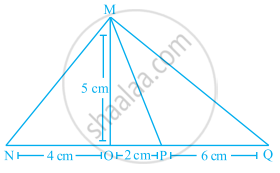Advertisements
Advertisements
प्रश्न
The points A(2, 9), B(a, 5) and C(5, 5) are the vertices of a triangle ABC right angled at B. Find the values of a and hence the area of ∆ABC.
उत्तर
Given that, the points A(2, 9), B(a, 5) and C(5, 5) are the vertices of a ΔABC right angled at B.
By Pythagoras theorem,
AC2 = AB2 + BC2
Now, by distance formula,
AB = `sqrt((a - 2)^2 + (5 - 9)^2)` ...(i) `[∵ "Distance between two point" (x_1, y_1) "and" (x_2, y_2) = sqrt((x_2 - x_1)^2 + (y_2 - y_1)^2)]`
= `sqrt(a^2 + 4 - 4a + 16)`
= `sqrt(a^2 - 4a + 20)`
BC = `sqrt((5 - a)^2 + (5 - 5)^2`
= `sqrt((5 - a)^2 + 0)`
= 5 – a
And AC = `sqrt((2 - 5)^2 + (9 - 5)^2`
= `sqrt((-3)^2 + (4)^2`
= `sqrt(9 + 16)`
= `sqrt(25)`
= 5
Put the values of AB, BC and AC in equation (i), we get
(5)2 = `(sqrt(a^2 - 4a + 20))^2 + (5 - a)^2`
⇒ 25 = a2 – 4a + 20 + 25 + a2 – 10a
⇒ 2a2 – 14a + 20 = 0
⇒ a2 – 7a + 10 = 0
⇒ a2 – 2a – 5a + 10 = 0 ...[By factorisation method]
⇒ a(a – 2) – 5(a – 2) = 0
⇒ (a – 2)(a – 5) = 0
∴ a = 2, 5
Here, a ≠ 5, since at a = 5, the length of BC = 0.
It is not possible because the sides AB, BC and CA form a right angled triangle.
So, a = 2
Now, the coordinate of A, B and C becomes (2, 9), (2, 5) and (5, 5), respectively.
∵ Area of ΔABC = `1/2[x_1(y_2 - y_3) + x_2(y_3 - y_1) + x_3(y_1 - y_2)]`
∴ Δ = `1/2[2(5 - 5) + 2(5 - 9) + 5(9 - 5)]`
= `1/2[2 xx 0 + 2(-4) + 5(4)]`
= `1/2(0 - 8 + 20)`
= `1/2 xx 12`
= 6
Hence, the required area of ΔABC is 6 sq units.
APPEARS IN
संबंधित प्रश्न
Find the relation between x and y if, the points A(x, y), B(-5, 7) and C(-4, 5) are collinear.
Show that the following sets of points are collinear.
(1, −1), (2, 1) and (4, 5)
For what value of a point (a, 1), (1, -1) and (11, 4) are collinear?
Show that the points A (3,1) , B (0,-2) , C(1,1) and D (4,4) are the vertices of parallelogram ABCD.
Using determinants, find the values of k, if the area of triangle with vertices (–2, 0), (0, 4) and (0, k) is 4 square units.
If A, B, C are the angles of a triangle, then ∆ = `|(sin^2"A", cot"A", 1),(sin^2"B", cot"B", 1),(sin^2"C", cot"C", 1)|` = ______.
The area of a triangle with vertices A(3, 0), B(7, 0) and C(8, 4) is ______.
Find the area of the triangle whose vertices are (–8, 4), (–6, 6) and (–3, 9).
The area of a trapezium is 475 cm2 and the height is 19 cm. Find the lengths of its two parallel sides if one side is 4 cm greater than the other.
Ratio of areas of ∆MNO, ∆MOP and ∆MPQ in the given figure is ______.

